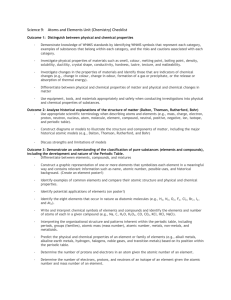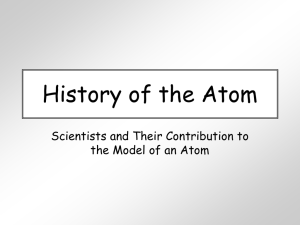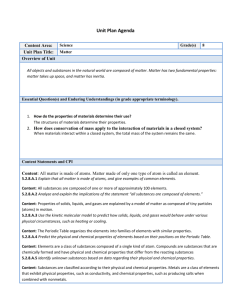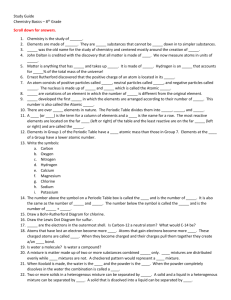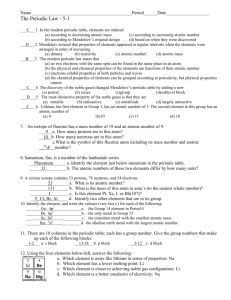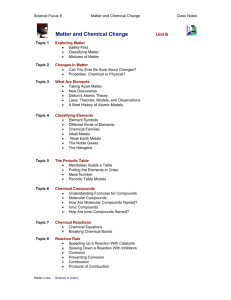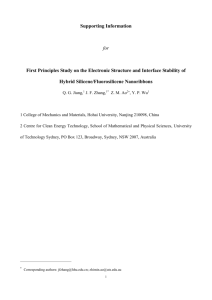Science 90 AE Outcom..
advertisement
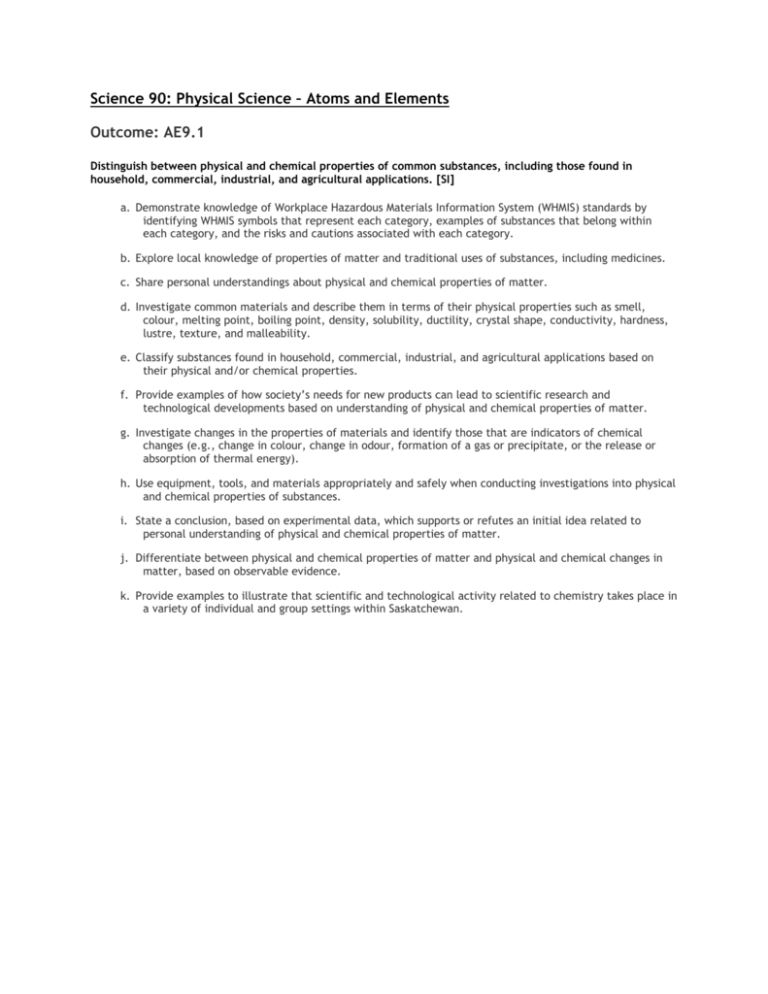
Science 90: Physical Science – Atoms and Elements Outcome: AE9.1 Distinguish between physical and chemical properties of common substances, including those found in household, commercial, industrial, and agricultural applications. [SI] a. Demonstrate knowledge of Workplace Hazardous Materials Information System (WHMIS) standards by identifying WHMIS symbols that represent each category, examples of substances that belong within each category, and the risks and cautions associated with each category. b. Explore local knowledge of properties of matter and traditional uses of substances, including medicines. c. Share personal understandings about physical and chemical properties of matter. d. Investigate common materials and describe them in terms of their physical properties such as smell, colour, melting point, boiling point, density, solubility, ductility, crystal shape, conductivity, hardness, lustre, texture, and malleability. e. Classify substances found in household, commercial, industrial, and agricultural applications based on their physical and/or chemical properties. f. Provide examples of how society’s needs for new products can lead to scientific research and technological developments based on understanding of physical and chemical properties of matter. g. Investigate changes in the properties of materials and identify those that are indicators of chemical changes (e.g., change in colour, change in odour, formation of a gas or precipitate, or the release or absorption of thermal energy). h. Use equipment, tools, and materials appropriately and safely when conducting investigations into physical and chemical properties of substances. i. State a conclusion, based on experimental data, which supports or refutes an initial idea related to personal understanding of physical and chemical properties of matter. j. Differentiate between physical and chemical properties of matter and physical and chemical changes in matter, based on observable evidence. k. Provide examples to illustrate that scientific and technological activity related to chemistry takes place in a variety of individual and group settings within Saskatchewan. Science 90: Physical Science – Atoms and Elements Outcome: AE9.2 Analyze historical explanations of the structure of matter up to and including: o o o o Dalton model Thomson model Rutherford model Bohr model of the atom. [SI] a. Propose personal explanations for the structure and/or composition of matter. b. Use appropriate scientific terminology when describing atoms and elements (e.g., mass, charge, electron, proton, neutron, nucleus, atom, molecule, element, compound, neutral, positive, negative, ion, isotope, and periodic table). c. Describe First Nations and Métis views on the nature and structure of matter. d. Identify major shifts in understanding matter that have enabled more detailed explanations of the structure and composition of the atom up to and including the Bohr model of the atom. e. Construct models to illustrate the structure and components of matter, including the major historical atomic models (e.g., Dalton, Thomson, Rutherford, and Bohr), using information selected and synthesized from various sources. f. Evaluate individual and group processes used in planning and completing a task related to constructing models of atoms and molecules. g. Discuss strengths and limitations of models in science using historical and contemporary examples of atomic models. h. Provide examples of technologies that have enhanced, promoted, or made possible scientific research about the structure of the atom (e.g., microscope, cathode ray tube, and mass spectrometer). i. Pose new questions and problems that arise from what was learned about atomic structure (e.g., “Why do different molecules containing the same elements behave differently?” “How do atoms stick together in a molecule?” “Are there smaller particles than electrons, protons, and neutrons?”). Science 90: Physical Science – Atoms and Elements Outcome: AE9.3 Demonstrate an understanding of the classification of pure substances (elements and compounds), including the development and nature of the Periodic Table. [SI] a. Differentiate between elements, compounds, and mixtures (mechanical mixtures and solutions), with reference to the terms homogenous and heterogeneous. b. Classify pure substances as elements or compounds. c. Construct a graphic representation of one or more elements that symbolizes each element in a meaningful way and contains relevant information such as name, atomic number, possible uses, and historical background. d. Identify examples of common elements (e.g., first 18 elements and K, Ca, Fe, Ni, Cu, Zn, I, Ag, Sn, Au, W, Hg, Pb, and U), and compare their atomic structure and physical and chemical properties. e. Identify the eight elements that occur in nature as diatomic molecules (e.g., H₂, N₂, O₂, F₂, Cl₂, Br₂, I₂, and At₂). f. Identify and evaluate potential applications of understanding of the characteristics of elements (e.g., identify fertilizers as a possible application of elements, and evaluate the potential use of given elements when choosing a fertilizer). g. Write and interpret chemical symbols or formulae of common elements and compounds and identify the elements and number of atoms of each in a given compound (e.g., He, Na, C, H₂O, H₂O₂, CO, CO₂, CaCO₃, SO₂, FeO, NO₂, O₃, CH₄, C₃H₈, NH₃, NaHCO₃, KCl, HCl, H₂SO₄, ZnO, and NaCl). h. Construct Bohr model representations of the first 18 elements. i. Trace the historical development of the modern periodic table and compare alternative arrangements that convey information about the classification of elements. j. Apply the concept of systems as a tool by interpreting the organizational structure and patterns inherent within the periodic table, including periods, groups (families), atomic mass (mass number), atomic number, metals, non-metals, and metalloids. k. Predict the physical and chemical properties of an element or family of elements (e.g., alkali metals, alkaline-earth metals, hydrogen, halogens, noble gases, and transition metals) based on its position within the periodic table. l. Determine the number of protons and electrons in an atom given the atomic number of an element. m. Determine the number of electrons, protons, and neutrons of an isotope of an element given the atomic number and mass number of an element. n. Discuss the difference between the use of the terms “law” and “theory” in science with reference to the periodic law and the atomic theory of matter.
